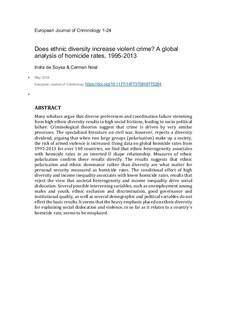| dc.description.abstract | Many scholars argue that diverse preferences and coordination failure stemming from high ethnic diversity results in high social frictions, leading to socio-political failure. Criminological theories suggest that crime is driven by very similar processes. The specialized literature on civil war, however, reports a diversity dividend, arguing that when two large groups (polarization) make up a society, the risk of armed violence is increased. Using data on global homicide rates from the period 1995–2013 for over 140 countries, we find that ethnic heterogeneity is associated with homicide rates in an inverted U-shape relationship. Measures of ethnic polarization confirm these results directly. The results suggests that ethnic polarization and ethnic dominance rather than diversity are what matter for personal security measured as homicide rates. The conditional effect of high diversity and income inequality is associated with lower homicide rates, results that reject the view that societal heterogeneity and income inequality drive social dislocation. Several possible intervening variables, such as unemployment among males and youth, ethnic exclusion and discrimination, good governance and institutional quality, as well as several demographic and political variables, do not affect the basic results. It seems that the heavy emphasis placed on ethnic diversity for explaining social dislocation and violence, in so far as it relates to a country’s homicide rate, seems to be misplaced. | nb_NO |
